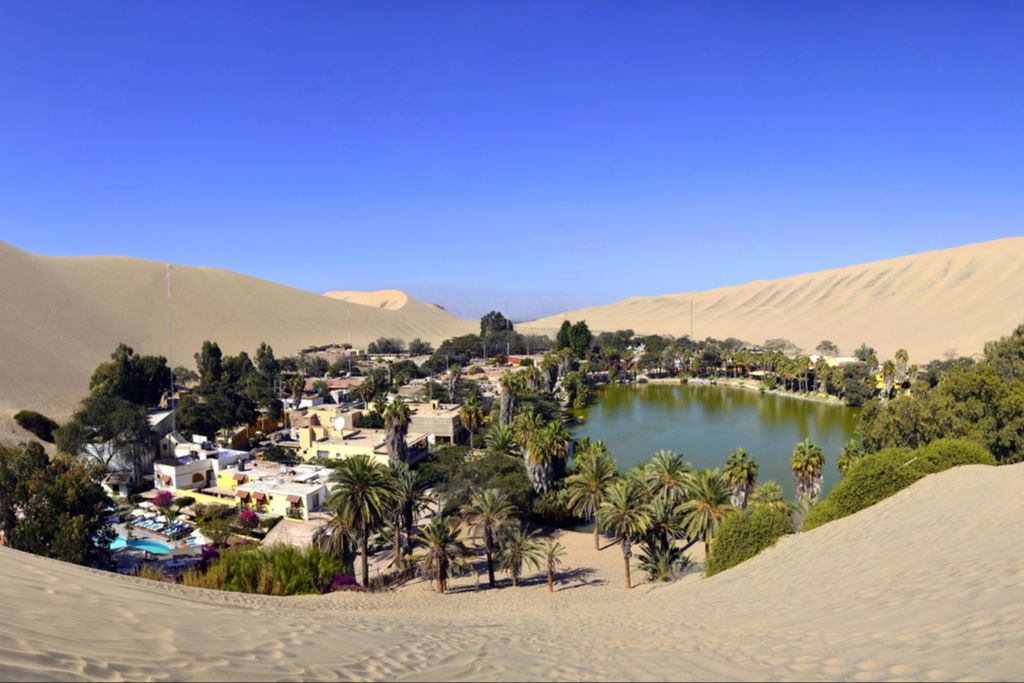
Peru is one of the most thrilling destinations in Latin America — and a personal favorite of mine. If you have at least 2 weeks in Peru, you can plan an epic, action-packed trip to this Andean nation. Here’s exactly how.
From the lush Amazon rainforest to the dry deserts of the coast, from the high Andean mountains to the picturesque colonial cities, Peru seriously ticks every box.
It’s also one of the easiest countries to travel around in terms of logistics and budget. You’ll often be surrounded by others with their backpacks on, ready to explore. So you can relax your shoulders and breathe; you’re about to go on the adventure of a lifetime!
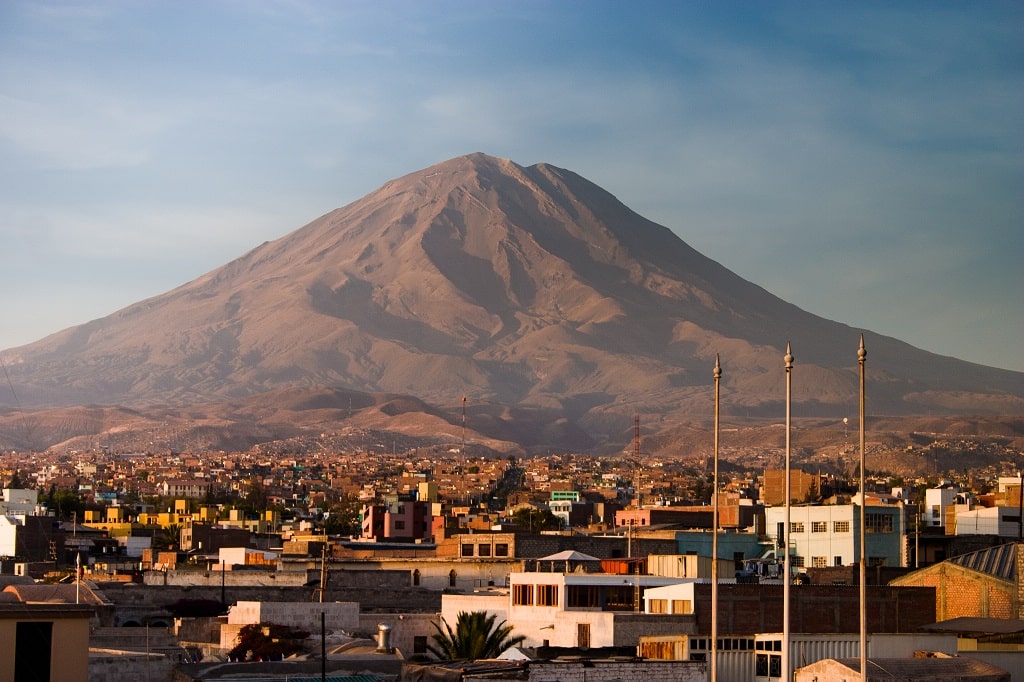 Towering over Arequipa, El Misti Volcano sets the scene for adventure
Towering over Arequipa, El Misti Volcano sets the scene for adventure
How to spend 2 or 3 weeks in Peru
Peru is huge, and if you’re taking buses to get around, you can expect some 12+ hour rides. That means you should choose your destinations carefully, especially if you spend only two weeks in the country.
3 weeks is a more comfortable trip length as it will let you see Peru at a more relaxed pace, or have more stops along the way. So, if you can stretch your trip to 3 weeks, I do recommend it. If so, you can follow this 2-week itinerary, but include more of the options I’ve listed at the end.
Here, I’ve laid out a traditional journey for exploring Peru, but that doesn’t mean you have to do it exactly like this. If you want to save Machu Picchu for the last week, then by all means, or if you want to skip the jungle and spend more time in the mountains, that’s up to you. I don’t believe in the ‘perfect’ itinerary as it depends on the individual traveller, so think of this as a template!

Week 1: Cusco + Machu Picchu
Machu Picchu—the mother of all wonders. It’s no surprise that it is one of the most iconic destinations in South America. The wonder of the world is at the top of everyone’s bucket list, and once you lay eyes on it and wander through the ancient ruins, you’ll understand why.
Even though the ancient site is getting busier every year, forcing new timeslot-based ticketing to be introduced, you really can’t go to Peru and not see Machu Picchu—it feels like that should be illegal.
So, in our first week, we are setting off to Cusco, the heart of the Inca Empire and the gateway to Machu Picchu.
Days 1 & 2 – Cusco
 Crisp mountain air drifting through the high-altitude alleys of old Cusco (videobuzzing/Depositphotos.com)
Crisp mountain air drifting through the high-altitude alleys of old Cusco (videobuzzing/Depositphotos.com)
Located in the southeast of Peru, Cusco is a perfect mix of colonial charm and Inca culture. The streets are covered in cobblestones, you can stroll through colorful markets, and ancient ruins will transport you back in time.
Even though it’s the most touristy city in Peru, it’s just about everyone’s favorite. There are loads of back streets to get lost in, cute cafes, and some of the best food in Peru. For some original ideas, check out our unobvious things to do in Cusco.
You can’t quite hit the ground running as soon as you arrive in Cusco. The city sits at 3,400 meters (11,200 feet) above sea level, so you’ll need to take it easy for your first couple of days in Cusco to acclimatize to the altitude! Here’s how to do it right:
The locals will tell you to chew on coca leaves, which, they say, helps with altitude sickness. I’m not sure if that’s been proven, but you can give it a try and see if it works for you
- Drink plenty of water and coca tea, and try to avoid alcohol and heavy meals.
- If you’re really struggling, you can buy some altitude sickness pills.
- The locals will tell you to chew on coca leaves, which, they say, helps with altitude sickness. I’m not sure if that’s been proven, but you can give it a try and see if it works for you
With only two weeks, you don’t have days to waste, so I recommend acclimatizing for at least a day. Don’t worry, you can spend the day exploring the Plaza de Armas, the main square in Cusco, visit the San Pedro Market, or eat some delicious Peruvian food.

How to Get to Cusco
Flying
If Cusco and Machu Picchu are your first stops on your Peruvian adventure, then you can take a flight to the Alejandro Velasco Astete International Airport. You might have a layover in Lima, but this is the easiest way to make the most of your time.
Overland
If you’re already in Peru and coming from another city, then you can get to Cusco by bus or plane. You’ll find buses to Cusco from pretty much anywhere in Peru, and they’re usually way cheaper than a flight. But beware, some of these bus journeys can take up to 24 hours, so make sure you’re prepared for a long ride. Alternatively, you can take a short flight from Lima to Cusco, which takes about an hour and is the quickest way to get there.
A lot of backpackers will be on the Gringo Trail, which in Peru consists of starting in Lima, bussing to Huacachina for sandboarding, then on to Arequipa, Colca Canyon, and finally Cusco. This is an amazing route in Peru and one I highly recommend. You can also do it backward by starting in Cusco, but taking the night bus from Arequipa is one of the most popular ways to get to Cusco.
book a bus ride to Cusco
Where to stay in Cusco
The city’s greatest accommodation advantage is its strategic location as the gateway to Machu Picchu, while being a fascinating destination in its own right. Many hotels in Cusco are housed in beautifully restored colonial mansions or ancient Inca structures, with original stonework still standing strong. Staying here feels like sleeping inside a living museum.
But if you’re craving something a little more off the ground (literally), book a stay at the Skylodge Adventure Suites. They’re basically transparent capsules that hang from the side of a mountain in the Sacred Valley, just outside of Cusco. Reaching your “room” requires climbing a 400-meter steel ladder or hiking a challenging trail with ziplines. Once there, you’ll enjoy 300-degree views of the sacred valley from your suspended transparent pod, along with a serious adrenaline rush.
I’ve rounded up a few handpicked accommodation options worth checking out:
A 16th-century mansion with original Incan walls and colonial architecture transformed into a luxury hotel
Skylodge Adventure Suites
Transparent capsules suspended on a mountainside in the Sacred Valley offering 300-degree views for adventurous travelers
Located just two blocks from Plaza de Armas, featuring a large courtyard, daily activities, and high ratings for cleanliness and atmosphere
Exploring Cusco and beyond
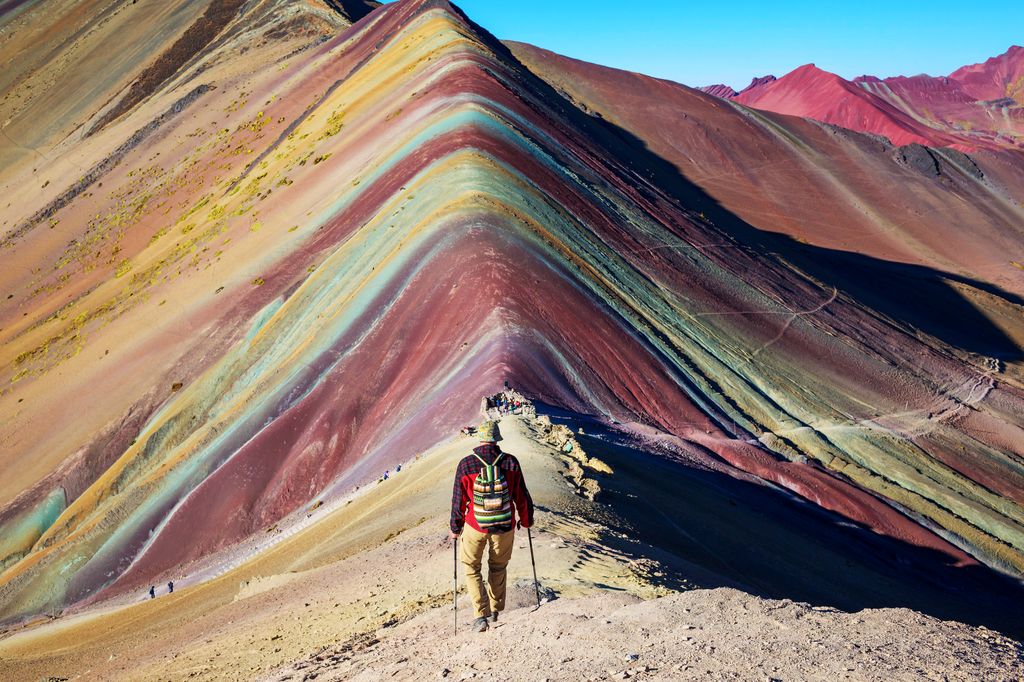
Cusco is the perfect home base for exploring the surrounding areas. Some of my favorite day trips from Cusco include the Sacred Valley, Maras and Moray, and Rainbow Mountain.
There are plenty of tour options available in Cusco for these destinations. For example, you can take this day trip from Cusco that includes guided tours of the stunning Rainbow Mountain and Red Valley.
The Sacred Valley is home to many Incan ruins, including the famous Machu Picchu. You can also visit Pisac Market, where you can find local handicrafts and souvenirs. Maras and Moray are known for their unique salt mines and agricultural terraces. And, of course, Rainbow Mountain has become one of Peru’s most famous attractions with its vibrant colors and challenging hike.
Days 3 & 7 – Machu Picchu
After getting acclimatized to the high altitude in Cusco, it’s time to make your way to Machu Picchu. It’s mindblowing to experience it in person and imagine the incredible engineering and architecture of the Incan Empire. Not only that, but the views are out of this world.
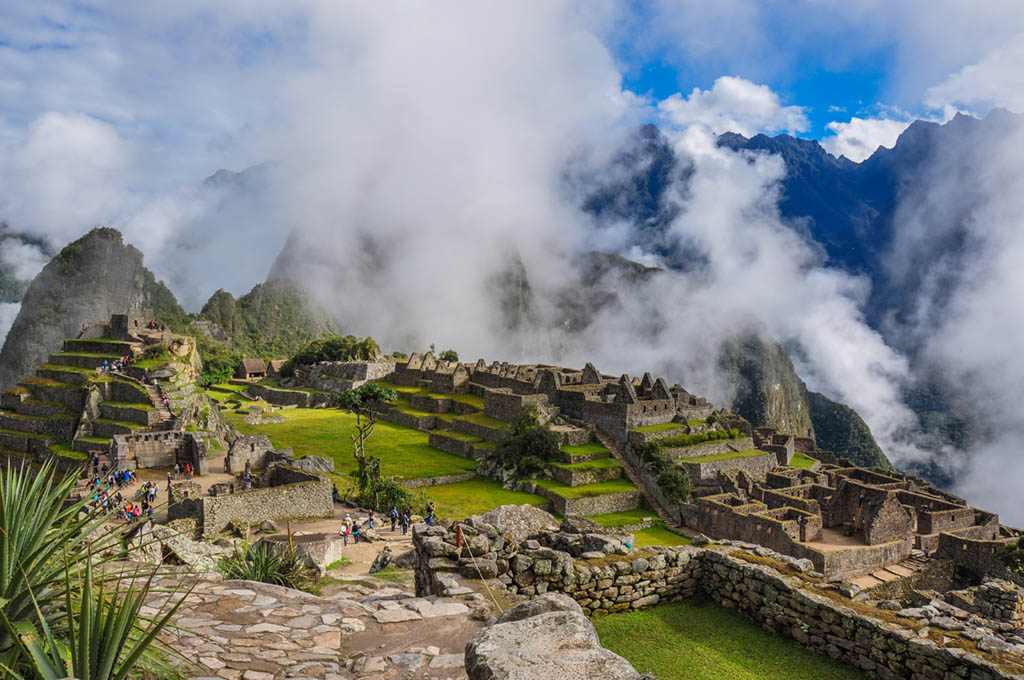
How to reach Machu Picchu
There are quite a few ways to reach Machu Picchu, and depending on your time constraints and Peru travel budget, you can choose the option that best fits you.
The most rewarding way to reach Machu Picchu is definitely by multi-day trek. But if you plan to get there by bus or train, you will need just 1 day to get to Machu Picchu. You can stay overnight at the nearest town, Aguascalientes, and spend more days sightseeing in and around Cusco.
Take the train
The quickest and easiest way to get to Machu Picchu is by train. You can choose to take the luxurious Hiram Bingham train or opt for a more affordable option like PeruRail or IncaRail. The train takes you to Aguas Calientes, the town at the base of Machu Picchu, where you can either hike up or take a short bus to the entrance.
You’ll catch the bus on the main road, and tickets can be purchased at the bus station or online in advance.
I recommend taking the train from Cusco the day before your entry ticket. This way, you can get a good night’s rest in Aguas Calientes and be ready to explore Machu Picchu bright and early.
After spending a few hours on the Incan site, you can take one of the later trains back to Cusco or Ollantaytambo. This will help you save time if you’re trying to see a lot in two weeks.
Hop on a bus
The most affordable way to get to Machu Picchu is by taking a local bus. You can catch a bus from Cusco to Ollantaytambo and then another one from Ollantaytambo to Hidroelectrica, the closest point accessible by road. From Hidroelectrica, you’ll need to hike about three hours along the train tracks until you reach Aguas Calientes.
A more convenient way is to use a tourist shuttle that goes direct from Cusco to Machu Picchu. Several reliable companies offer bus rides. Machu Picchu By Bus, for example, specializes in tourist-friendly service with multiple departure times to fit your schedule and operates modern buses (a real plus on these winding mountain roads). SAP Adventures is another option, offering flexible bookings.
Most platforms accept major credit cards and will send confirmation directly to your email – just remember to download or print your ticket before heading to the departure point, especially since cell service can be spotty in the more remote areas approaching Hidroelectrica.
Trekking to Machu Picchu (the adventure route)
Now, onto the fun stuff. If you’re looking for an adventure and some amazing views, hiking to Machu Picchu is the way to go.
There are two iconic ways to hike your way to Machu Picchu: the Inca Trail and the Salkantay Trek.
Both are multi-day adventures that need to be booked in advance, especially the Inca Trail, which is typically booked out months ahead due to strict permit limits. You can’t hike it on your own; only licensed tour operators are allowed access. But they’ll handle everything for you. These will set you up with any gear you need and will provide porters, food, and set-up camp.
This is the classic Peruvian trekking experience that follows the legendary Inca Trail through the ancient cloud forests and ruins, ending at the Sun Gate at sunrise—just in time to see Machu Picchu in all its glory.
(If the Inca Trail is fully booked, the Salkantay Trek is another famous trail that offers high-altitude views, fewer crowds, and a dramatic route to Machu Picchu.)
Permits for the Inca Trail are limited and sell out months in advance, so you’ll need to book early.
Trek 1: the classic Inca Trail
At its highest point, the Inca Trail soars above 4,200 meters — a true journey through the clouds  Views that mark the start of the hike ahead
Views that mark the start of the hike ahead  Approaching the ancient city of Machu Picchu on the final stretch of the trail
Approaching the ancient city of Machu Picchu on the final stretch of the trail
The Inca Trail is the most popular hiking route to Machu Picchu. It’s a four-day trek through the Andes Mountains, passing ancient Incan ruins and beautiful landscapes. The trail is relatively easy, but it does require some physical fitness as there are steep sections and high altitudes.
It’s a total of 26 miles (43 kilometers), and you’ll be camping along the way. If you don’t happen to have your own gear, don’t worry, as this is extremely common for travelers. The tour companies will provide you with everything you need. To help preserve this ancient route, only 500 people are allowed on the trail each day, and all must travel with official permits.
These top-rated, permit-only group treks offer the best routes to Machu Picchu:
Trek 2: Salkantay Trek
At its highest point, the Inca Trail soars above 4,200 meters — a true journey through the clouds  First checkpoint and camping site from the Salkantay trail
First checkpoint and camping site from the Salkantay trail  The postcard-perfect view you’ll get on the Salkantay Trek
The postcard-perfect view you’ll get on the Salkantay Trek
The Salkantay Trek is a more challenging route, but it also offers incredible views of the Andes Mountains and glaciers. This trek takes 5 days and covers a total distance of 46 miles (74 kilometers). It’s a bit less crowded than the Inca Trail, making it a great option for those looking for a more secluded experience.
There are several options for more comfortable stays along the way, such as mountain lodges or basic guesthouses, but camping is still common for certain portions of the trek.
However, the Salkantay Trek does require a higher level of physical fitness as you will be hiking at high altitudes and through rough terrain.
Unlike the Inca Trail, no permit is required for the Salkantay Trek, making it a more accessible option for last-minute adventurers. From my experience, the Salkantay is a favorite among hikers and has been named one of the top 25 best treks in the world.
Trek 3: the wild Inca Jungle Trek
 Getting my pulse racing on the Inca Jungle Trek
Getting my pulse racing on the Inca Jungle Trek
If you’re like me and you’re looking for more adrenaline and less hiking, then the Inca Jungle Trek might be the perfect option for you. This multi-day group trek includes activities such as mountain biking, rafting, and ziplining before reaching Machu Picchu. It takes four days and covers a total distance of 43 miles (69 kilometers).
This trek is ideal for adventure seekers who want to combine outdoor activities with the cultural experience of visiting Machu Picchu. It also offers a more budget-friendly option than the Inca Trail and Salkantay Trek.
Be sure to have your tickets for Machu Picchu! If you’re going in August or September, you’ll want to book your Machu Picchu tickets well in advance. If you’re doing a trek, double-check that it includes your entry to the archaeological site.
Once your tickets are secured, you can plan your two weeks in Peru a little better and know exactly which day you’ll be at Machu Picchu.
After Covid, Machu Picchu began dividing the site into different circuits: 1, 2, 3, and 4. These routes are one-way only and cannot be modified once you begin. So if you want the classic Machu Picchu picture from the viewpoint, you need to make sure your ticket includes circuits 1 or 2.
Week 2 in Peru
Your second week in Peru is seriously full of options. From exploring more of Cusco to heading down south towards Puno and Lake Titicaca or flying up north to the incredible city of Lima, there’s no shortage of things to do.
I don’t believe there is ever a universal ‘perfect’ itinerary, as everyone has different interests, so for this second section, I’ll be presenting several options.
Option 1: Arequipa, Huacachina, and Lima
The most popular destinations to visit before or after Cusco are Arequipa, Huacachina, and Lima. Especially if you’re still on a hiking buzz!
Days 8 & 10 – Arequipa
Arequipa at sunset, watched over by the mighty Misti Volcano Colca Canyon will take your breath away—literally
You can hop on a night bus to Arequipa from Cusco. It takes about 12 hours, but it’s highly worth it. Arequipa is known for its beautiful colonial architecture and the nearby Colca Canyon, which is deeper than the Grand Canyon.
If you want the full scoop, we have some suggestions for the best things to do in Arequipa.
You can do a two-day trek at Colca Canyon, making your way down to the bottom of the canyon and camping overnight. If you’re short on time, you can do a day trip to see the condors.
A restored 18th-century colonial mansion with original sillar stone features and volcano views.
A boutique hotel in a republican-era building with a rooftop terrace overlooking Misti volcano.
Cosy homestay in a traditional wooden house inside the park
Days 11 & 12 – Huacachina
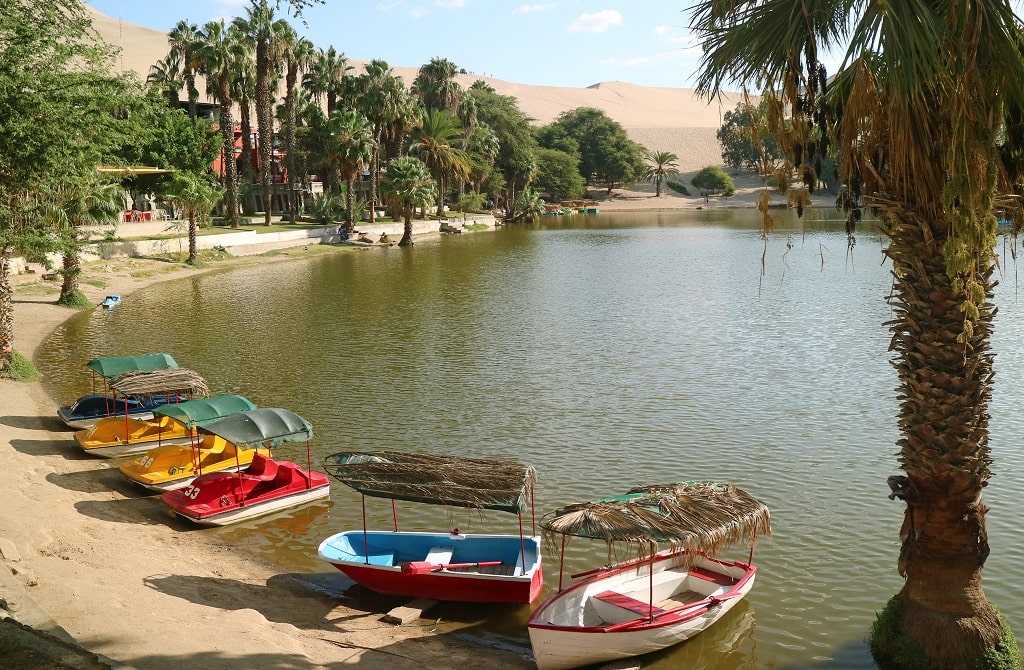 An adrenaline-packed desert oasis – perfect for sandboarding, dune buggies, and breathtaking views await
An adrenaline-packed desert oasis – perfect for sandboarding, dune buggies, and breathtaking views await
Snag another night bus and head to the famous desert oasis, Huacachina. This small town is built around a natural lagoon surrounded by massive sand dunes. Squint your eyes and you might think you’re in the Sahara.
Spend the day enjoying the sun at these lower altitudes, then take a dune buggy ride and go sandboarding down the dunes at sunset. (It’s wild! I had no idea it would feel like a roller coaster through the desert.)
Days 13 & 14 – Lima
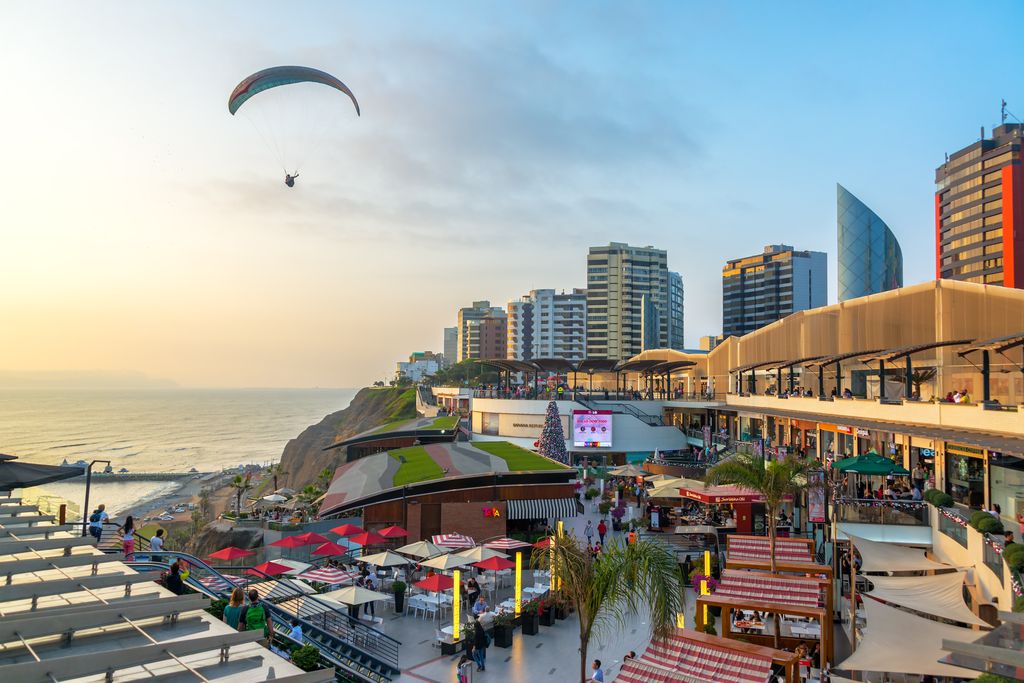 So much to see in one shot of Lima’s coastline!
So much to see in one shot of Lima’s coastline!
Finally, make your way to Lima for your last two days in Peru. This bustling city is known for its incredible food scene and vibrant nightlife.
I should mention that Cusco and Arequipa are much more picturesque cities, and not everyone is impressed with Lima if it’s their first sight of Peru. However, I promise the capital is well worth exploring if you set your expectations appropriately. If you need any convincing, read our take on whether Lima is worth visiting.
Just a heads up, Lima can be pretty dodgy if you stumble into the wrong areas. And it’s not called “la Gris” for nothing (meaning gray). The skies are just about always overcast, and it’s pretty ugly with some hefty traffic.
If you wish to avoid the traffic noise and chaos of the center, then Miraflores and Barranco (by the coast) offer more relaxed locations to stay. They’re safe, and you’ll be able to walk in most places.
Some people love Lima, some people hate it. But there’s one thing Lima definitely has in spades: amazing food! Make sure to try some of Peru’s famous dishes like ceviche, lomo saltado, and aji de gallina. Peru seriously has one of the best cuisines. Oh, and don’t forget to wash it all down with a Pisco Sour, the national drink of Peru.
The following accommodations are in the 3 neighborhoods I recommend staying:
- Miraflores offers safety, ocean views, and the beautiful El Malecón boardwalk.
- Barranco attracts creative types with its colorful streets, art galleries, and vibrant nightlife.
- San Isidro provides a quieter experience with leafy parks, upscale shopping, and business district convenience.
A trendy hostel in Lima’s safest district, featuring co-working spaces, yoga deck, and movie room -perfect for digital nomads and social travelers.
Second Home Peru | Barranco
An artistic guesthouse in oceanfront Barranco, set in a restored mansion filled with artwork and surrounded by gardens with sea views.
Country Club Lima Hotel | San Isidro
A historic 5-star hotel in San Isidro, featuring elegant rooms in a 1920s colonial building, with pool access and adjacent to the Lima Golf Club.
Option 2: Iquitos and the Amazon
If you’re looking to see a completely different side of Peru, head up north to Iquitos and venture into the Amazon rainforest.
You can take a short flight from Cusco to Iquitos and then hop on a boat to cruise along the river and experience the unique wildlife and culture of the Amazon.
Days 8 & 9 – Iquitos
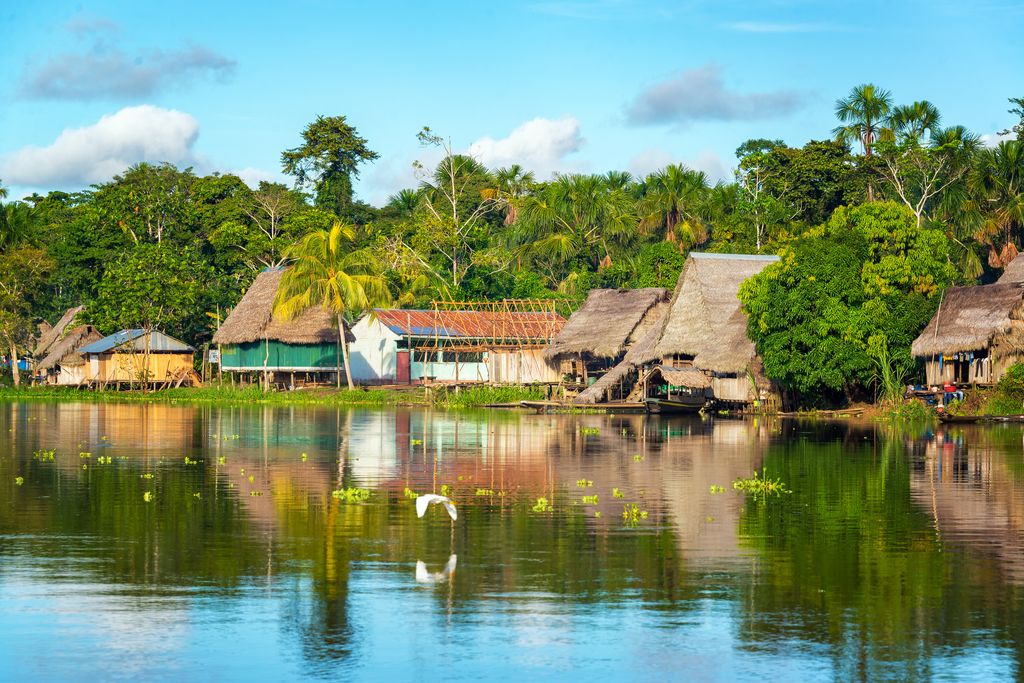 Thatched roofs and stilted homes paint an epic scene in Iquitos
Thatched roofs and stilted homes paint an epic scene in Iquitos
Iquitos is the largest city in the world that can’t be reached by road, so regardless of which city you’re coming from, you’ll have to fly in.
As soon as you arrive, you’ll instantly be hit by the hot and humid climate of the jungle. Spend your first day exploring the city and visiting the huge Belen market. Be prepared for a complete culture shock coming from the mountains. You’ll see huge meat markets with carcasses hanging in the open air and piles of exotic fruits and vegetables.
Days 10 & 13 – Amazon River
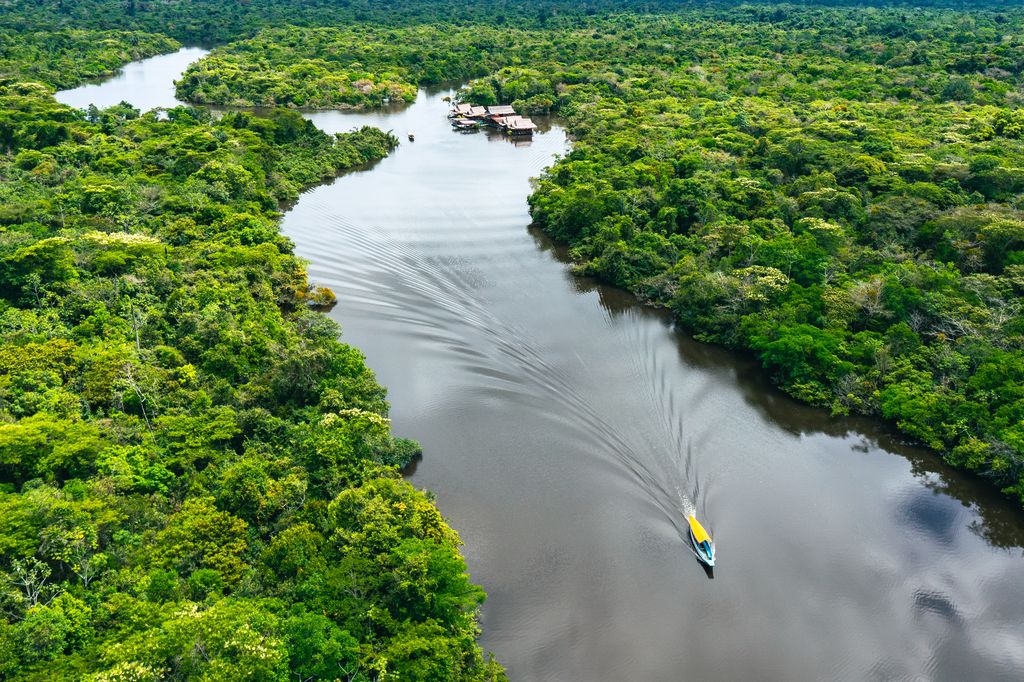 The Peruvian Amazon…
The Peruvian Amazon…
The next few days will be spent in the Amazon rainforest. There are loads of different tours and experiences. I highly recommend doing 3 nights/4 days. It takes 3-4 hours by boat to get to the lodge from Iquitos, and you’ll be fully surrounded by nature. Wake up to the sound of howler monkeys, go on a sunrise canoe ride, and explore the jungle with expert guides.
The days will be filled with jungle walks, piranha fishing, caiman spotting at night, and visiting local communities to learn about their way of life in the rainforest. And if you’re feeling really brave, you can meet a shaman and try traditional plant medicine ceremonies.
Don’t forget to bring a book—Wi-Fi is a no-go in the Amazon!
Once you’ve soaked in the wild beauty of the rainforest, make your way back to Iquitos and catch a flight to Lima for one final adventure-packed day in Peru!
Day 14 – Lima
If you’re a surfer, you can catch the longest left-handed wave in the world at Chicama. Otherwise, spend your day exploring the historic center of Lima, and make sure to eat all the ceviche you can before heading home.
Option 3: Lake Titicaca and Bolivia
When you’re in Cusco, you’re actually rather close to Bolivia, so why not take a detour and explore the beautiful Lake Titicaca and check off a new country?
This will be a fast-paced week with a lot of travel, but once you reach Puno, everything is much closer than the 12-hour-night buses Peru offers.
Days 8 & 9 – Puno
 The famous Uros floating islands on Lake Titicaca
The famous Uros floating islands on Lake Titicaca
Take a bus from Cusco to Puno, the gateway city to Lake Titicaca. Spend a day exploring the city and its markets, and make sure to try some local delicacies like alpaca meat.
Take a boat trip to the famous Uros floating islands. These man-made islands are made entirely of reeds and have been home to indigenous communities for centuries. You’ll learn about their way of life and spend time with the locals before heading back to Puno for the night.
Days 10 & 11 – Copacabana
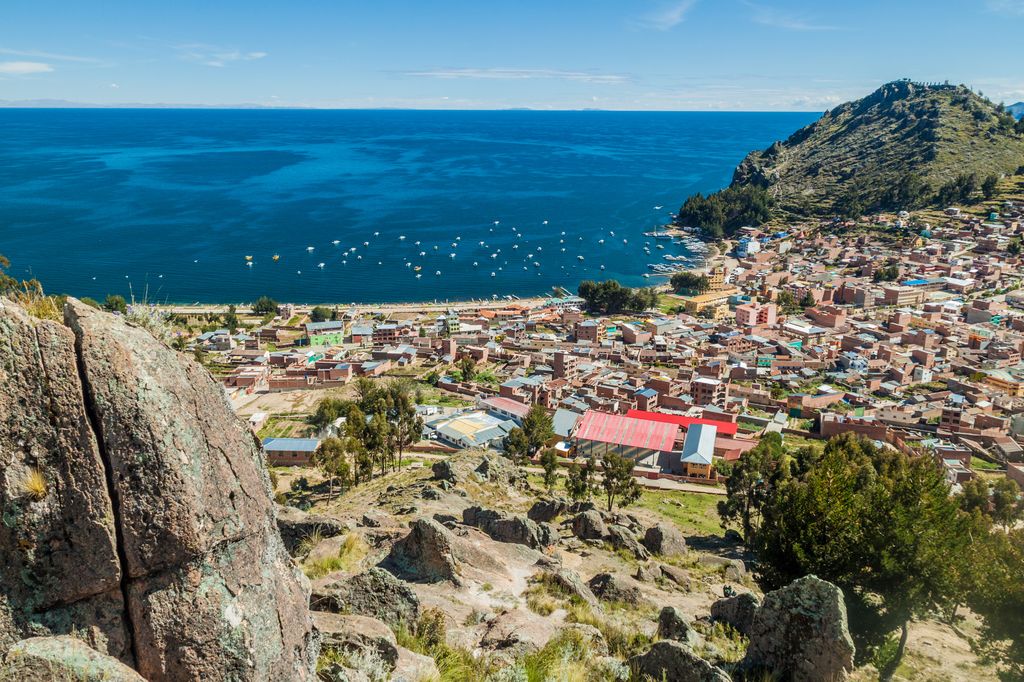 Copacabana from above
Copacabana from above
Cross the border into Bolivia and make your way to Copacabana, a charming town on the shores of Lake Titicaca. Take a tour of Isla del Sol, the legendary birthplace of the Inca Empire. You can also hike to the top of Cerro Calvario for stunning views of the lake and surrounding mountains.
Note for American travellers: Just a reminder, if you’re American, you will need a pricey little visa to enter Bolivia. While most Western countries can enter for free, the US requires a $160 visa. You can pay on arrival in cash.
Day 12 – La Paz
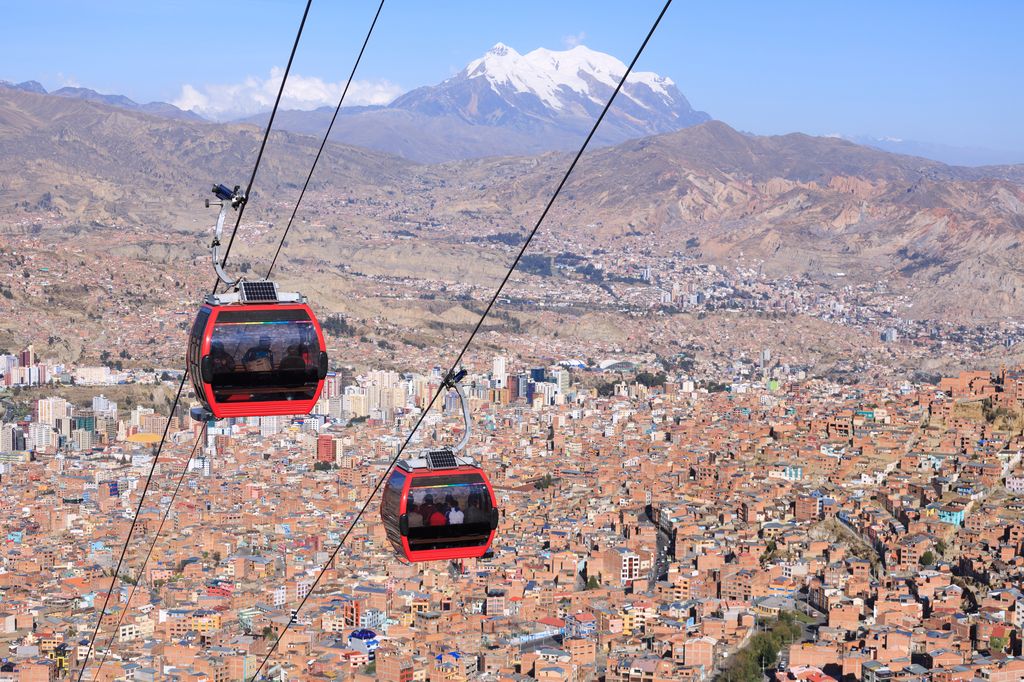
Take a bus to La Paz, Bolivia’s capital city. Spend your day exploring the colorful markets and vibrant street art.
You can take a cable car ride to El Alto for breathtaking views of the city and the surrounding Andes mountains. The city doesn’t have many must-see attractions, but just walking around and immersing yourself in the culture is an experience in itself.
Days 13 & 14 – Salar de Uyuni
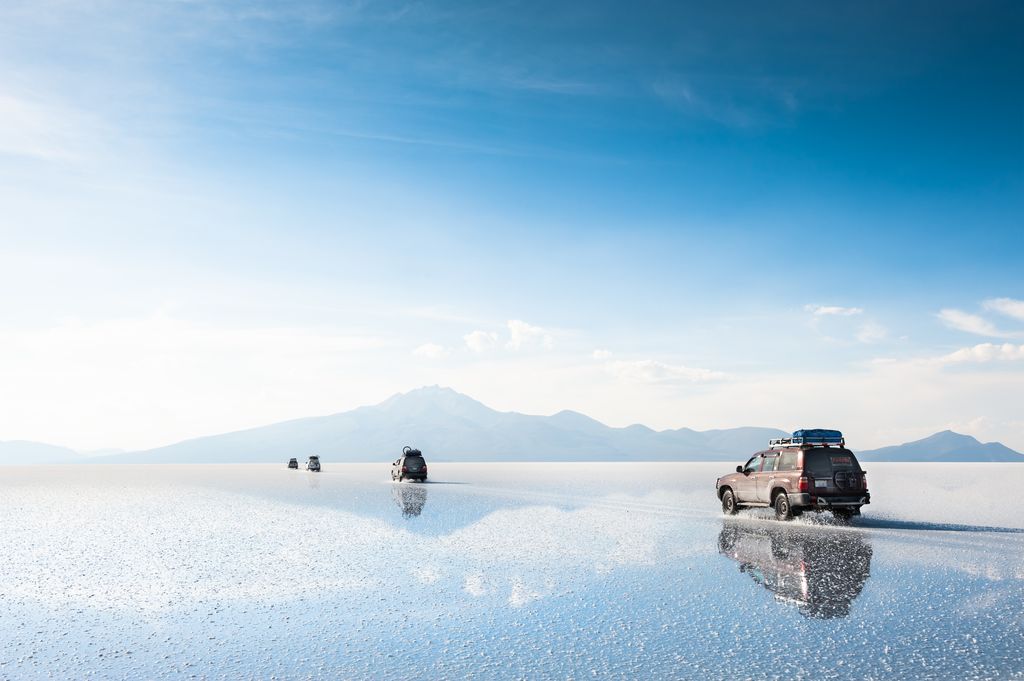 Icy or salty…
Icy or salty…
No trip to Bolivia is complete without a visit to the otherworldly Salar de Uyuni, the largest salt flat in the world. Take a guided tour of the vast expanse of white salt, towering cacti, and colorful lagoons filled with flamingos. Your guide will have all the fun little props for you to take some amazing photos on the salt flat.
With two weeks in Peru you have so many options for experiencing all the South American gem has to offer. You just have to decide what your budget is and what experiences matter most to you.
Whether you want to trek through the Andes, explore ancient ruins, or immerse yourself in local culture, Peru has something for everyone. Of course, you can always go back — and trust me, after you taste the ceviche and a pisco sour, you’ll definitely want to!
Please visit:
Our Sponsor
